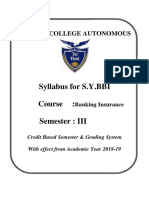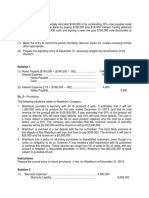MonetaryEc MonetaryEconomicsMajor
MonetaryEc MonetaryEconomicsMajor
Uploaded by
ahangerj96Copyright:
Available Formats
MonetaryEc MonetaryEconomicsMajor
MonetaryEc MonetaryEconomicsMajor
Uploaded by
ahangerj96Original Title
Copyright
Available Formats
Share this document
Did you find this document useful?
Is this content inappropriate?
Copyright:
Available Formats
MonetaryEc MonetaryEconomicsMajor
MonetaryEc MonetaryEconomicsMajor
Uploaded by
ahangerj96Copyright:
Available Formats
CLUSTER UNIVERSITY SRINAGAR Eco
Department of Economics
uGHTENS
UG- 3rd Semester (NEP)
NOWLEDGE ENLIC Subject: - Economics
Course Titlc: Monetary Economics Course Type: (Major)
Course Code: UGECO22.J301 Total Credits: 06;( Theory: 04; Tutorial/Practical = 02)
Objectives: The objective of this course "Monetary Economics" is to provide students with a comprehensive
understanding of concepts and measures of money supply. The course enables the students to understand the
structure and working of Indian Financial System andconduct of monetary policy by the RBI.
Learning Outcomes:
LO1: Demonstrate a clear understanding of the fundamental concepts of money, its evolution, and the
functions.
L02: Analyse and evaluate how to measure Money supply.
LO3: Analyse the structure role and working of Indian banking system and Monetary Policy.
L04: Understanding the role and working of Indian Financial System.
Unit I. Basic Concepts
Money and its Functions, Kinds of Money, Approaches to Definition of Money: Conventional,
Chicago, Gurley and Shaw, and Central Bank Approaches. Evolution of Monetary Standards
from Gold Standard to Paper Standard, Gresham's Law, Principles of Note Issue: Currency and
Banking Principle.
Unit II. Money Supply
Money Supply and its measures, Concept of ligh-Powered Money, Determinants of High
Powered Money,Concept of Money Multiplier, Credit Multiplier and Deposit Multiplier.
Unit III. Indian Financial System-I
Overview of Indian Financial System; Banking and Non-Banking Financial Institutions;
Commercial Banks: RRB's and Development Banks: Central Banking: RBI and its functions:
Monetary policy: Objectives and Instruments; Monetary policy comnnittee: Composition and
functions; Inflation Targeting.
Unit I . Indian Financial System-II
Financial Markets: Money & Capital Market; Money market instruments-Treasury bills,
Commercial bills, Certificate of Deposit, Call money; Stock Exchange Markets (NSE & BSE):
Capital market instruments- Shares, Bonds and Debentures; SEBIand its Role.
Tutorials
Assignment/Group Discussions/ Presentation/Quiz/Book Revicw/Ficld Survey (Followcd by Viva
Voce)
Unit V. Working of Digital Money and Cryptocurrency
Assets and liabilitiesof commercial banks.
Working of Cooperatives and Microfinance institutions (SHG's)
Unit VI.
Eco- (02)
Credit Creation by Commercial Banks - Using Hypothetical Data
Performance indicators ofmaior Indian stocks
Survey on financial literacy and payment mechanisms
Suggested Readings:
1. Gupta, S. B. (2010). Monetary Economics: Institutions, Theory & Policy. S Chand & Company (1
December 2010).
2. Sethi,T.T (2005). Money, Banking and lnternational Trade. SChand Publication.
3. Khan, M. Y. (2015). Indian Financial System. McGraw Hill Publication.
4. Bhalla, V. K. (2020). Money, Banking, and Financial Markets in India. S. Chand Publishing.
5. Mishkin, F. S.(2018). Money, Banking, and Financial Markets. Pearson Education.
6. Pathak, B. V. (2019). Indian Financial System. Pearson Education.
7. Bhole, L.M. (2017)Financial Institutions and Markets. Mc Graw Hill.
You might also like
- Delay AnalysisDocument99 pagesDelay AnalysisPrince Ahmed Diboo93% (27)
- Bill of Exchange PDFDocument23 pagesBill of Exchange PDFNuwan Tharanga LiyanageNo ratings yet
- Hybrid Financing: Preferred Stock, Leasing, Warrants, and ConvertiblesDocument29 pagesHybrid Financing: Preferred Stock, Leasing, Warrants, and ConvertiblesUmer Ali KhanNo ratings yet
- Conflicts of Interest FlowchartDocument1 pageConflicts of Interest Flowchartvarshnis20% (1)
- Economics Minor SyllabusDocument2 pagesEconomics Minor Syllabussyedmuhayir3No ratings yet
- MBA 3 Electives PDFDocument20 pagesMBA 3 Electives PDFSanika YadavNo ratings yet
- Part (A) Indian Banking Credit:3: MOD NO. Detailed Syllabus Teaching Hours Objective of The Module Teaching MethodologyDocument3 pagesPart (A) Indian Banking Credit:3: MOD NO. Detailed Syllabus Teaching Hours Objective of The Module Teaching Methodologyrajat_177229No ratings yet
- Fassh Bbe Sem 2Document11 pagesFassh Bbe Sem 2Areena KumariNo ratings yet
- Sem 2 SyllabusDocument49 pagesSem 2 SyllabushankschraderimpNo ratings yet
- SyllabusDocument8 pagesSyllabusyamumini07100% (1)
- IFS SyllabusDocument2 pagesIFS SyllabusLAKSHMIDHARNo ratings yet
- DSE 5 Money and Financial MarketDocument2 pagesDSE 5 Money and Financial Marketsikusu61No ratings yet
- Revised Syllabus of Continuous Professional Development ExaminationsDocument8 pagesRevised Syllabus of Continuous Professional Development ExaminationsSprasadNo ratings yet
- 4.36 M.com Banking & FinanceDocument18 pages4.36 M.com Banking & FinancegoodwynjNo ratings yet
- Group B - Financial Management - Paper IDocument2 pagesGroup B - Financial Management - Paper IRobert MythbustNo ratings yet
- RBI Grade B Syllabus Phase 2 For StudyDocument3 pagesRBI Grade B Syllabus Phase 2 For Studyahil XO1BDNo ratings yet
- New Syllabus For BCOM Semester Wise 2018-19Document22 pagesNew Syllabus For BCOM Semester Wise 2018-19Ashutosh AgarwalNo ratings yet
- Paper NO. BCH 5.4 (B) - Financial Markets, Institutions and ServicesDocument6 pagesPaper NO. BCH 5.4 (B) - Financial Markets, Institutions and Servicessuccess keyNo ratings yet
- Faculty of Commerace: Lcuknow UniversityDocument22 pagesFaculty of Commerace: Lcuknow UniversityAryan KakkarNo ratings yet
- MMS Financial Markets and Institutions 1Document167 pagesMMS Financial Markets and Institutions 1Sonali MoreNo ratings yet
- Faculty of Commerace: I YearDocument23 pagesFaculty of Commerace: I YearKaran Veer SinghNo ratings yet
- PGDM II FINANCE ElectivesDocument21 pagesPGDM II FINANCE ElectivesSonia BhagwatNo ratings yet
- Financial Markets, Institutions and Services (SAPR)Document4 pagesFinancial Markets, Institutions and Services (SAPR)VampireNo ratings yet
- 1.7.2 - Financial Institutions and MarketsDocument1 page1.7.2 - Financial Institutions and MarketsSuresh JayaramaNo ratings yet
- FIMSDocument264 pagesFIMSPrakash ReddyNo ratings yet
- BMT1012 Indian-Financial-System TH 1.0 0 BMT1012Document2 pagesBMT1012 Indian-Financial-System TH 1.0 0 BMT1012Ayeesha K.s.No ratings yet
- Syllabus For BankingDocument15 pagesSyllabus For BankingAnil NamosheNo ratings yet
- Financial Market and ServicesDocument12 pagesFinancial Market and Servicesbarshaadhikari83No ratings yet
- Session Plan - Banking - Class of 2022Document6 pagesSession Plan - Banking - Class of 2022ZeusNo ratings yet
- LLM (Syllabus) 2018 (1 Yr Program)Document25 pagesLLM (Syllabus) 2018 (1 Yr Program)Faizan BhatNo ratings yet
- BBA-F603 Financial Institutions and MarketDocument2 pagesBBA-F603 Financial Institutions and Marketraja14feb2000No ratings yet
- FMI Syllabus Notes NCWEBDocument54 pagesFMI Syllabus Notes NCWEBmahekprakash91No ratings yet
- Indian EconomyDocument1 pageIndian Economymahiedanish910No ratings yet
- Financial ServicesDocument2 pagesFinancial ServicesRasika KambliNo ratings yet
- MBA3069 Commercial Banking CHODocument14 pagesMBA3069 Commercial Banking CHOMohit JamwalNo ratings yet
- Diploma, Anna University-UG, PG., HSC & SSLC: Ba5008 Banking Financial Services ManagementDocument2 pagesDiploma, Anna University-UG, PG., HSC & SSLC: Ba5008 Banking Financial Services ManagementSruthi KunnasseryNo ratings yet
- Faculty of Commerce, Lucknow University: Group - A Paper (I) - Micro EconomicsDocument40 pagesFaculty of Commerce, Lucknow University: Group - A Paper (I) - Micro EconomicsRaman SrivastavaNo ratings yet
- FS FSMDocument3 pagesFS FSMAniketh KNo ratings yet
- MBA-Financial AdministrationDocument38 pagesMBA-Financial Administrationanjalibhopale1169No ratings yet
- Economics For Money & Banking Complete Notes Till Unit 4Document82 pagesEconomics For Money & Banking Complete Notes Till Unit 4Naman SharmaNo ratings yet
- Gujarat Technological UniversityDocument3 pagesGujarat Technological UniversityabhanidharaNo ratings yet
- Banking - Theory and Practices 18MBAFM31-1Document88 pagesBanking - Theory and Practices 18MBAFM31-1Nandeep Hêãrtrøbbér50% (2)
- SLM-19667-BBA - Fiancial Markets and InstitutionsDocument155 pagesSLM-19667-BBA - Fiancial Markets and InstitutionsMadhusudan0% (1)
- Mcom Fe 3Document354 pagesMcom Fe 3Sumit Kumar GautamNo ratings yet
- HSM Hu401Document2 pagesHSM Hu401randomhuu768No ratings yet
- CAIIBITDocument27 pagesCAIIBITMLastTryNo ratings yet
- FINANCEDocument5 pagesFINANCESridhar KodaliNo ratings yet
- Financial Markets and Services R19 SYLLABUSDocument1 pageFinancial Markets and Services R19 SYLLABUSmba departmentNo ratings yet
- Money and Banking Mgt-304Document3 pagesMoney and Banking Mgt-304Anonymous 7nY38BNo ratings yet
- BBI SyllabusDocument3 pagesBBI SyllabusMegha Nair PillaiNo ratings yet
- Indian Institute of Banking & Finance: CAIIB SyllabusDocument15 pagesIndian Institute of Banking & Finance: CAIIB Syllabusveeresh2907No ratings yet
- IV AccDocument9 pagesIV AccAzharNo ratings yet
- Syllabus For S.Y.BBI Course: Semester: III: Jai Hind College AutonomousDocument15 pagesSyllabus For S.Y.BBI Course: Semester: III: Jai Hind College AutonomousMukeshNo ratings yet
- Money Banking and Public Finance SyllabusDocument4 pagesMoney Banking and Public Finance SyllabusRadhika PrasadNo ratings yet
- Mba - FT & PTDocument7 pagesMba - FT & PTNawin KumarNo ratings yet
- Bba Ib 3 SylDocument6 pagesBba Ib 3 SylShivam RawatNo ratings yet
- Banking FinalDocument5 pagesBanking FinalAks MaroNo ratings yet
- Financial Markets InstitutionsDocument3 pagesFinancial Markets Institutions1088Anushka SharmaNo ratings yet
- S Y B A EconomicsDocument9 pagesS Y B A EconomicsAshashwatmeNo ratings yet
- 18 MBA 201 Corporate Finance Credit: 3, Class Hours: 35Document15 pages18 MBA 201 Corporate Finance Credit: 3, Class Hours: 35sid misraNo ratings yet
- Course Outline Economics-IIDocument4 pagesCourse Outline Economics-IITanishka TomarNo ratings yet
- Investment Management: A Modern Guide to Security Analysis and Stock SelectionFrom EverandInvestment Management: A Modern Guide to Security Analysis and Stock SelectionNo ratings yet
- Abebe, Setegn, Sileshi, Solomon, Melkamu, Ruhama PDFDocument20 pagesAbebe, Setegn, Sileshi, Solomon, Melkamu, Ruhama PDFsileshi fenitaNo ratings yet
- BEST Mechanical & Electronic Locks - 2015 v2Document108 pagesBEST Mechanical & Electronic Locks - 2015 v2Security Lock DistributorsNo ratings yet
- Andaya v. Rural Bank of CabadbaranDocument8 pagesAndaya v. Rural Bank of CabadbaranClara SawaliNo ratings yet
- Core Risks in BankingDocument52 pagesCore Risks in BankingSoloymanNo ratings yet
- Brandon Smith - Trump Cannot Be Anti-Globalist While Working With Global Elites - Zero HedgeDocument4 pagesBrandon Smith - Trump Cannot Be Anti-Globalist While Working With Global Elites - Zero HedgeCarlos Suriel100% (1)
- Victorydepot PDFDocument2 pagesVictorydepot PDFAbrar PatelNo ratings yet
- Cod Fiscal 2024. Comparatie Cu 2022 Si 2023.Document9 pagesCod Fiscal 2024. Comparatie Cu 2022 Si 2023.1hunterasdNo ratings yet
- Credit TransactionDocument3 pagesCredit Transactionhermione_granger10No ratings yet
- Corporate Governance TheoriesDocument54 pagesCorporate Governance Theoriessinou70% (1)
- Managing & Measuring Translation ExposureDocument19 pagesManaging & Measuring Translation ExposureMalkeet SinghNo ratings yet
- The PhilippinesDocument15 pagesThe PhilippinesKatherine AquinoNo ratings yet
- EFA Agreement Early TerminationDocument2 pagesEFA Agreement Early TerminationKhoa PhanNo ratings yet
- 8 1 5 PDFDocument4 pages8 1 5 PDFAbyssNo ratings yet
- Leontief QuantitativeInputOutput 1936Document26 pagesLeontief QuantitativeInputOutput 1936FábioNo ratings yet
- Reports Handled by RTCDDocument2 pagesReports Handled by RTCDNicou RobinNo ratings yet
- Placement Portal Registration GuideDocument7 pagesPlacement Portal Registration GuideTime TravelerNo ratings yet
- Nomura Strategy 03 11Document106 pagesNomura Strategy 03 11Thiago PalaiaNo ratings yet
- Constant Growth ModelDocument6 pagesConstant Growth ModelReenalNo ratings yet
- USDC AnalysisDocument13 pagesUSDC AnalysisBurj al FerreroNo ratings yet
- Increment FormDocument2 pagesIncrement FormRam Thalluri100% (1)
- 17 06 16 FAQ On Gold BondDocument2 pages17 06 16 FAQ On Gold BondPM LOgsNo ratings yet
- MEDIA-AnnualReport2007 (3MB) PDFDocument236 pagesMEDIA-AnnualReport2007 (3MB) PDFSharma Reddy Sri RamuluNo ratings yet
- Pawn of Finance Monetary CrisisDocument140 pagesPawn of Finance Monetary CrisisRobert MacDonald100% (1)
- Akuntansi+Vol +2+no +3+September+2023+Hal+109-126Document18 pagesAkuntansi+Vol +2+no +3+September+2023+Hal+109-126masyahimirafiNo ratings yet
- Assignment 3 - Semester 1 - 2022Document11 pagesAssignment 3 - Semester 1 - 2022Ziphelele VilakaziNo ratings yet
- Exe Ch.13Document4 pagesExe Ch.13kenny 3220160480% (1)

























































































